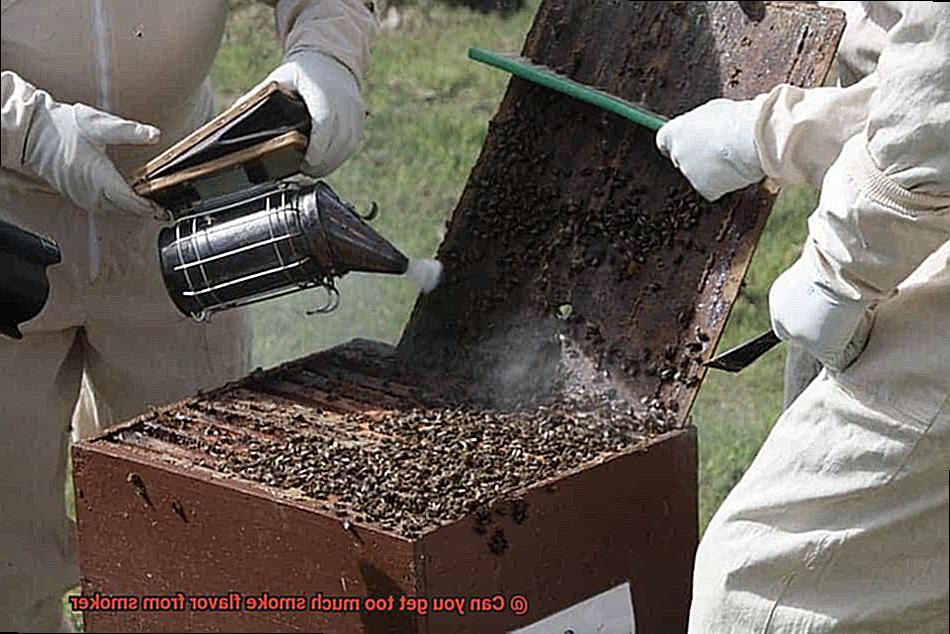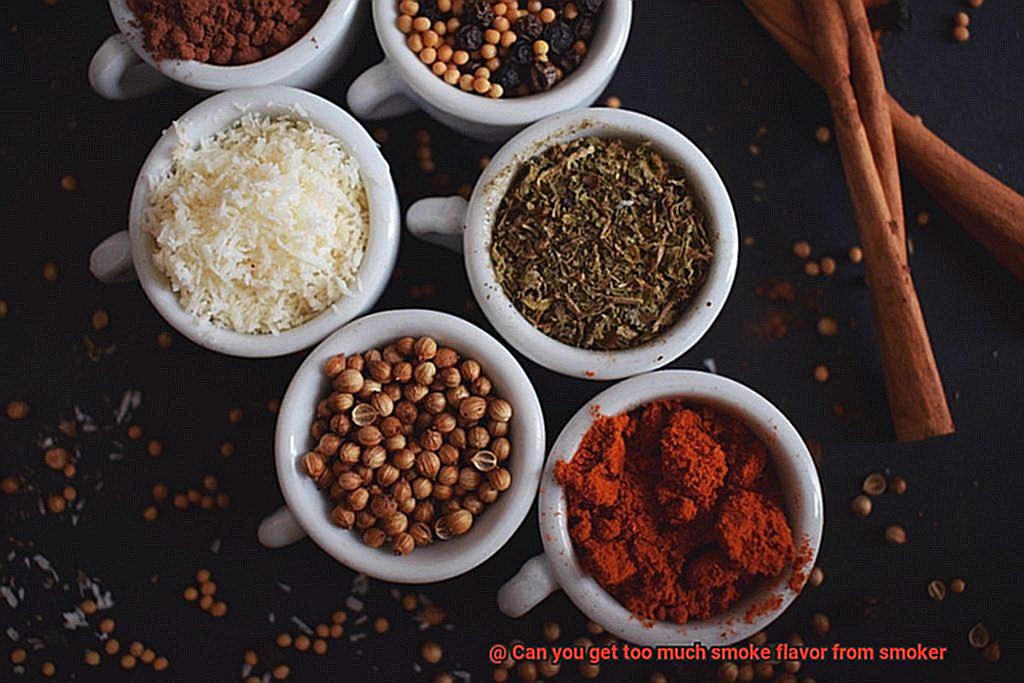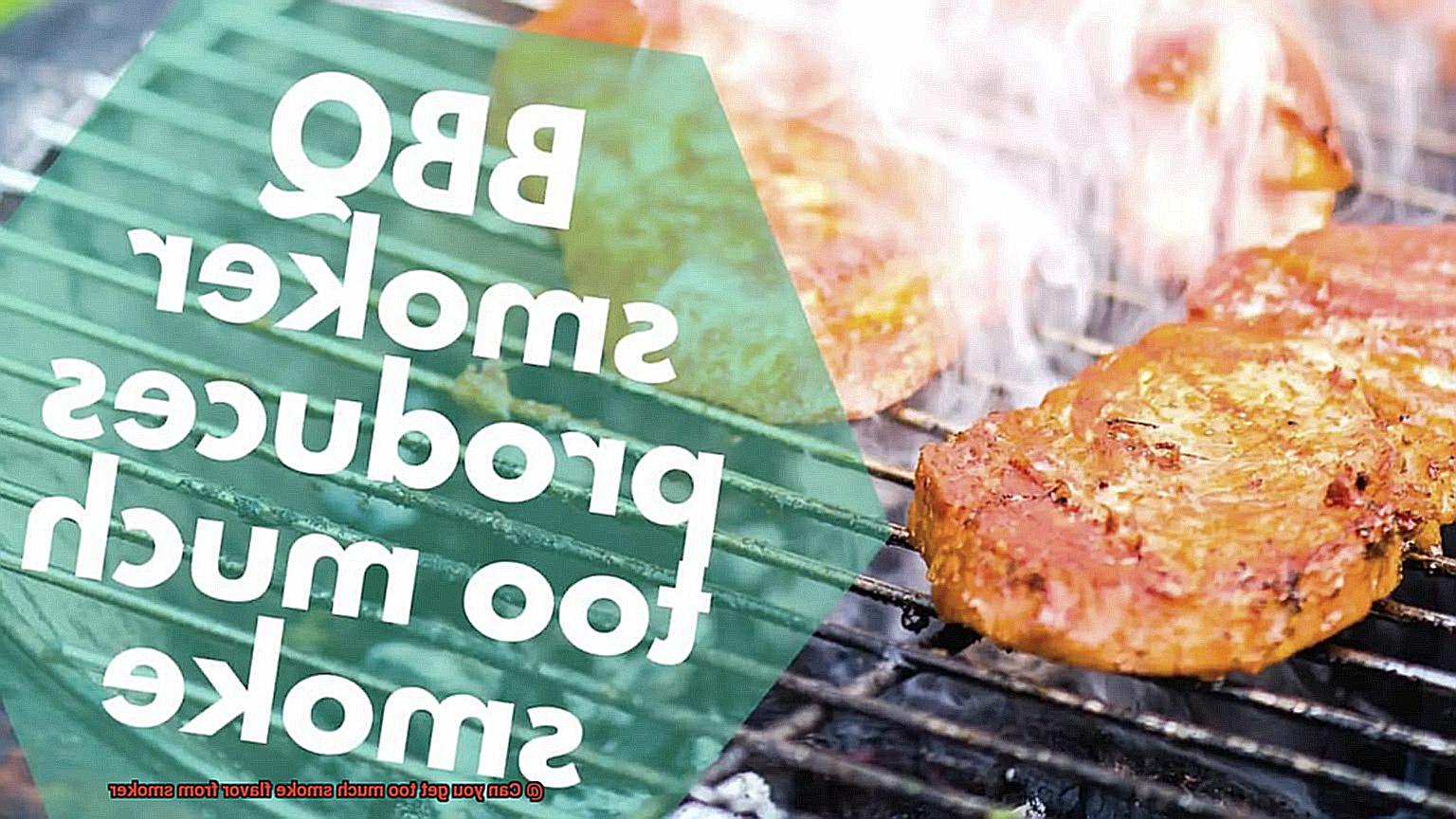Imagine this: You’re outside with your smoker, the aroma of smoky meat filling the air. The anticipation is making everyone’s mouth water. But what if the smoke becomes too much? Can you really get too much smoke flavor from a smoker?
As an expert on smokers, I can tell you that yes, it’s possible. Smoking your meat adds a juicy flavor and irresistible texture, but over-smoking can be a real pitfall. Too much smoke can overpower the other flavors in your food and even make it taste bitter.
But don’t worry, there are ways to avoid over-smoking and get your meat just right. By adjusting the amount and type of wood used, monitoring the temperature of your smoker, and paying attention to the amount of smoke produced, you can ensure a perfectly smoked meal every time.

In this blog post, we’ll dive deeper into the world of smokers and explore what over-smoking is, why it happens, and how to prevent it. You’ll learn about the science behind smoking and how to achieve just the right amount of smoky flavor in your meat while avoiding common mistakes.
Whether you’re a seasoned smoker or just starting out, read on to discover how to avoid getting too much smoke flavor from your smoker and how to achieve that perfect balance of smoky goodness in every bite.
Contents
What Causes Too Much Smoke Flavor?
Smoking meat is an art that requires balance. Too much smoke can turn a delicious meal into a bitter, acrid, or burnt disaster. So, what causes too much smoke flavor in your smoker? Let’s take a closer look at the factors that could be contributing to this problem.
Over-smoking is one of the most common causes of too much smoke flavor. When meat is left in the smoker for too long, it absorbs too much smoke, creating an overly smoky taste. This is particularly true for delicate meats like fish or chicken. To avoid this, it’s essential to monitor your meat regularly and remove it from the smoker once it reaches the desired level of smokiness.
Using too much wood is another factor that can lead to an over-smoked flavor. Different types of wood have varying smoke intensities, so using the right amount and type of wood is crucial. For example, hickory is a strong wood best suited for beef or pork, while applewood is milder and works well with chicken or fish. Research which woods work best for your desired meat to achieve the perfect level of smokiness.
Poor ventilation can also contribute to too much smoke flavor. Smoke can become trapped inside your smoker if there isn’t enough airflow, creating an overly smoky environment. To avoid this, ensure that your smoker has enough air flow to keep the smoke moving evenly.
Finally, a dirty smoker can create an overly smoky taste due to a buildup of creosote or debris. Regularly cleaning your smoker and removing any excess debris will help prevent this from happening.
How to Avoid Over-Smoking
Smoking meat is an art, and achieving the perfect balance of smokiness can be a challenge. Over-smoking can ruin the taste of your dish, leaving you with an overwhelming smoke flavor that masks the natural flavors of your food. However, with a few simple tips, you can avoid over-smoking and ensure that your meat is perfectly smoked.
Choose the Right Wood
The type of wood you use in your smoker is critical to achieving the perfect level of smoke flavor in your food. Different types of wood produce different levels of smoke, so it’s essential to choose one that complements the type of meat you’re smoking. For instance, applewood is a mild smoke that works well with poultry and pork, while hickory produces a stronger smoke that pairs well with beef and game meats.
Monitor the Temperature

The temperature inside your smoker has a direct impact on the amount of smoke produced. If the temperature is too low, the wood will produce more smoke, leading to an overpowering flavor. On the other hand, if it’s too high, the smoke will be less intense. It’s crucial to maintain a consistent temperature throughout the smoking process to achieve the desired level of smokiness.
Adjust Smoking Time
The longer your food stays in the smoker, the more smoke it will absorb. If you’re worried about over-smoking, consider reducing the smoking time or removing the food from the smoker once it reaches your desired level of smokiness. Remember that every meat and wood combination is unique, so experiment until you find what works best for you.
Properly Prepare Your Food

Before smoking your food, take care to trim excess fat and season appropriately. Proper seasoning can enhance the natural flavors of your food and prevent the smoke from overpowering it. Be mindful of other ingredients you’re using as well – some spices or marinades may contain ingredients that can contribute to the smokiness.
Use a Smoke Generator or Smoker Box
Using a smoke generator or smoker box is an excellent way to control the amount of smoke produced and prevent over-smoking. This method allows for better control over the smoke and prevents wood chips from burning too quickly, which can lead to an excessive amount of smoke.
The Different Types of Wood and Their Flavors
Smoking meat is a culinary art that requires careful consideration of the type of wood and its distinct flavor profile. In this article, we will delve deeper into the different types of wood used for smoking and their unique flavors.
Hardwoods vs. Fruitwoods
Hardwoods like oak, hickory, and mesquite produce a robust smoky flavor that pairs well with beef and pork. In contrast, fruitwoods like apple, cherry, and peach produce a milder flavor that works well with fish and poultry.
Regional Preferences
Different regions of the United States have their own preferences for specific types of wood. For example, in Texas, mesquite is a popular choice for smoking brisket due to its intense smoky flavor, while in the Carolinas, hickory is preferred for pork because it adds complexity to the meat’s taste.
Avoid Softwoods
Softwoods like pine or cedar should never be used for smoking as they contain high levels of resin that can ruin the flavor of your food.
Hickory
Hickory is one of the most popular woods used for smoking, and it’s known for its bold, smoky flavor. This wood is commonly used for smoking pork, beef, and poultry due to its strong aroma and taste.
Mesquite
Mesquite is a wood that is native to the Southwest United States and is known for its intense smoky flavor. It’s often used for grilling and smoking meats like beef, pork, and chicken due to its boldness.
Apple

Apple wood has a mild, fruity flavor that pairs well with poultry, pork, and fish. It’s also a popular choice for smoking cheese due to its delicate flavor profile.
The Benefits of Smoking Meat
Smoking meat is a culinary practice that has been celebrated for centuries. It involves cooking meat slowly over wood smoke, which infuses the meat with a unique flavor and aroma. But what exactly are the benefits of smoking meat? Let’s take a closer look.
One of the most apparent benefits of smoking meat is the flavor it imparts. The smoky taste is unparalleled and can’t be replicated by other cooking methods. It’s a favorite among those who love grilled or barbecued food and makes for an unforgettable dining experience.
In addition to being delicious, smoking meat is also a healthier option than frying or grilling. During the process, the fats in the meat are rendered out, resulting in a leaner and healthier meal. This makes it an excellent choice for people who want to indulge in flavorful food without compromising on their health.
Smoking meat is also an excellent way to tenderize tough cuts of meat. The slow cooking process breaks down the connective tissue, resulting in a more enjoyable eating experience. You can turn even the toughest cuts of meat into mouth-watering dishes that will impress your guests.
Another benefit of smoking meat is its extended shelf life. Smoked meats can last for several weeks, making it a convenient option for those who want to cook in bulk or stock up on food for future use. In the past when refrigeration was not widely available, smoking meat was a way to preserve it for later consumption.
Furthermore, smoking meat can be a social activity that brings people together around the smoker. Many people enjoy the process of smoking meat and take pride in creating their own unique blends of wood chips and spices. It can be an enjoyable hobby for those who love cooking and entertaining.
Finding the Right Balance for Your Smoker
If you’re ready to take your barbecue game to the next level, smoking your meat is the way to go. However, achieving the perfect balance of smoky flavor can be a bit of a challenge. In this post, we’ll explore some essential tips for finding the right balance for your smoker.
First and foremost, choosing the right smoker for your needs is crucial. With so many smokers on the market, it’s important to consider the amount of smoke you want before making a purchase. Some smokers produce more smoke than others, so keep that in mind when making your selection.
Once you have your smoker, controlling the amount of smoke it produces is key. You can do this by adjusting the airflow and temperature inside the smoker. Keep in mind that more air flowing through the smoker will result in less smoke, while higher temperatures will produce less smoke as well.
Another essential factor to consider is the type of wood or pellets you use in your smoker. Different types of wood produce different levels of smoke, so experimenting with various varieties until you find the perfect balance for your taste buds is worth it.
Timing is also critical when it comes to smoking food. Over-smoking can ruin your meat and make it taste bitter. Make sure to monitor your food closely and remove it from the smoker as soon as it’s cooked to your desired level of doneness.
To summarize, finding the right balance when smoking food is essential for achieving mouth-watering results. To achieve this balance, choose the right smoker, control airflow and temperature, experiment with different types of wood, and monitor your food closely. By doing so, you’ll be able to achieve just the right amount of smoky goodness without overpowering your dish.
Tips for Achieving the Perfect Amount of Smoke Flavor
Smoking meat is an art that requires a delicate balance of flavors to achieve the perfect taste. The right amount of smoke flavor can make or break a dish, so it’s important to follow some tips to ensure the end result is mouthwatering and delicious.

Choose the right wood
The type of wood you use in your smoker can greatly impact the level of smoke flavor in your meat. Some woods, like mesquite or hickory, are bold and strong, while others like fruitwoods or oak are milder and sweeter. It’s important to choose wisely and experiment with different woods to find the perfect flavor for your taste buds.
Control the temperature
Temperature control is crucial when smoking meat. If your smoker is too hot, the wood will burn too quickly and produce too much smoke, resulting in bitter meat. If it’s too cool, you may not get enough smoke flavor. Keeping your smoker between 225-250 degrees Fahrenheit is optimal for achieving the perfect amount of smoke flavor.
Be mindful of the amount of wood
Adding too much wood can be tempting when trying to achieve that perfect smoky taste, but it’s important to use a light hand with the wood. Too much wood can overpower the natural flavors of the meat and result in a bitter taste. Start with a small amount and adjust as needed.

Consider the cut of meat

Different cuts of meat have varying levels of natural flavor, so it’s important to take that into account when smoking. Fatty cuts like brisket can handle more smoke than leaner cuts like chicken breast. Experiment with different cuts to find what works best for you.
Don’t forget about seasoning and cooking techniques
While smoke flavor is important, it’s also crucial to focus on seasoning and cooking techniques to create a well-rounded dish. Use smoke flavor as a complement to other flavors rather than relying solely on it.
The Different Types of Smokers and How They Affect Smoke Flavor
Smoking meat is an art that requires the right equipment to achieve the perfect flavor. The type of smoker you use can significantly impact the smoke flavor, and it’s essential to understand the different types of smokers available. Here are five sub-sections explaining the different types of smokers and how they affect smoke flavor.
Electric Smokers:

Electric smokers use electricity to heat up a heating element that produces smoke from wood chips or pellets. They are known for producing a milder smoke flavor than other types of smokers, making them perfect for those who prefer a less intense smoky taste. However, it’s crucial to monitor the amount of smoke produced because it’s easy to over-smoke meat with an electric smoker. Over-smoking can cause a bitter or overpowering smoky flavor that ruins the taste of your meat.
Charcoal Smokers:
Charcoal smokers use charcoal as their primary source of fuel, which produces smoke as wood chips or chunks are added to the coals. They tend to produce a more intense smoke flavor than electric smokers, making them ideal for those who prefer a stronger smoky taste. However, the amount of charcoal used and the duration of smoking can significantly affect the intensity of smoke flavor. It’s easier to control the amount of smoke by adjusting the amount of wood added to the coals.
Wood Pellet Smokers:
Wood pellet smokers use compressed wood pellets as their primary source of fuel. They produce a more subtle smoke flavor than charcoal or wood smokers, making them ideal for those who prefer a less intense smoky taste. It’s still possible to over-smoke meat with a wood pellet smoker if you don’t pay attention to the amount of smoke produced. Therefore, it’s essential to keep an eye on the amount of smoke generated and adjust it accordingly.
Gas Smokers:
Gas smokers use propane or natural gas as their primary source of fuel. They produce a milder smoke flavor than other types of smokers, making them ideal for those who prefer a lighter smoky taste. However, it’s still possible to over-smoke meat using a gas smoker if it runs for too long. Therefore, it’s crucial to monitor the amount of smoke produced and adjust the smoker accordingly.
Offset Smokers:
Offset smokers use wood as their primary source of fuel and rely on indirect heat to smoke the meat. They produce a robust and intense smoke flavor that is perfect for those who love a strong smoky taste in their meat. However, it’s essential to maintain the correct temperature and airflow to prevent over-smoking. Over-smoking with an offset smoker can cause the meat to have a bitter or charred taste.
Common Mistakes People Make When Smoking Foods
Don’t worry, I’ve got you covered with some tips on how to avoid these common pitfalls for a perfectly smoked dish.
Firstly, using too much wood or charcoal can result in an overpowering, bitter taste that can ruin your food. Remember, less is more when it comes to smoking. Stick to the recommended amount of wood or charcoal for your smoker and adjust as needed. This will help you achieve a well-balanced smoky flavor without overpowering your dish.
Secondly, not properly preparing your meat or other ingredients before smoking can lead to an unsatisfying final product. Make sure to trim any excess fat from your meat before smoking it and season or marinade it beforehand for a delicious and well-rounded flavor profile. These small steps can make all the difference in the quality of your smoked foods.
Lastly, maintaining proper temperature and smoke levels throughout the process is crucial for achieving perfect smoked dishes. Keep an eye on your smoker and adjust the temperature and smoke levels as necessary to ensure even cooking and smoke distribution. This will prevent undercooked or overcooked food and ensure that each bite is infused with that delicious smoky flavor.
iaKwEQHuFqg” >
Conclusion
In conclusion, while smoke flavor can add a delicious depth to your dishes, it is possible to overdo it.
Too much smoke can overwhelm the natural flavors of your food and leave an unpleasant aftertaste. It’s important to find a balance that works for you and your taste preferences.
Remember, smoking is an art form – practice makes perfect.






